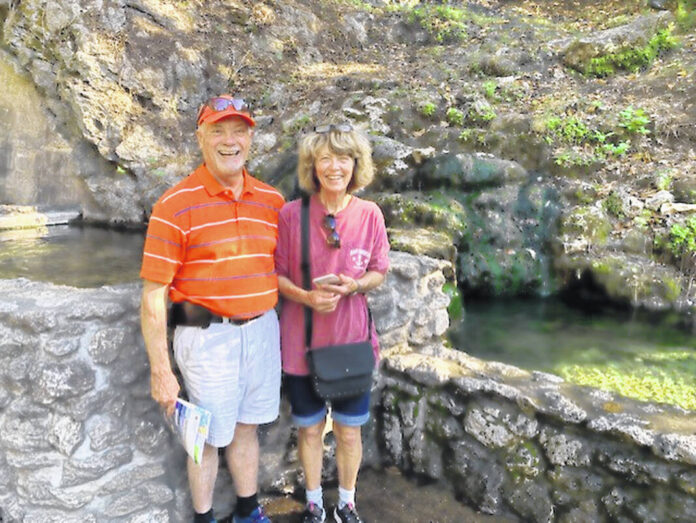On Lady Jane’s and my fall sojourn — leaving Little Rock behind after delving into the ignominious history of central High School and the Little Rock Nine — we headed for Hot Springs, a little over fifty miles away and a small city of around 38,000, but one as unique for its size you’re likely to find.
Two men, William Dunbar and George Hunter, while exploring in 1804, came upon some huts in the Ouachita Mountains, ones used by people to soak in the natural hot springs that bubbled up from some 7,000 feet below on a fault line on a mountainous slope. Once discovered, Congress passed legislation declaring the four-mile area where the springs were to be protected and available for public use. Word spread about the springs, and, over time, along what is now the city’s main north-south thoroughfare of Central Avenue, bathhouses were built, and more and more people came to soak in what was thought to be healing waters.
Following our check-in at a Quality Inn, our first stop in the downtown area was the city’s visitor center for tips and suggestions of how to use our three days’ worth of time. Surrounding the building was a walk of fame honoring folks from Arkansas who came to prominence. Established in 1996, among the many plaques were the likes of Bill Clinton and Maya Angelou, Glen Campbell and baseball third baseman extraordinaire Brooks Robinson as well as a number of celebrated fishermen. I took photos of those plaques and texted them to one of Lima’s best fisherman, my pal Steve Contini.
As for the National Park, it actually is quite unique since it begins just west of Central Avenue and just beyond Bathhouse Row, where people came in droves for a healing soak. Many of the old bathhouses are still there, although now leased by the National Parks to other businesses. One bathhouse is still operational, the Buckstaff, where you can still walk in and get the deluxe spa treatment for 99 bucks.
One of the former bathhouses, the Fordyce, is now the National Parks Visitor center, as well as a museum that has much of the original bathhouse layout in place to show how the operation worked. Both Lady Jane and I found it highly interesting.
Behind Bathhouse Row is the National Park Grand Promenade, a half-mile all-brick walkway that lies just below the rest of the park that extends up a mountainside and includes 5,550 acres and four mountain ranges- Hot Springs, Sugarloaf, North and South. Jane and I walked the bricks and paused to do what all tourists do when we came to the two uncapped hot springs, plunged our hand briefly into the 143-degree water with steam coming off it.
Later, we drove up into the park and took the elevator up the 216-foot Hot Springs Mountain Observation Deck to take in the view of the park and city below.
The city also has a rich baseball tradition. In the late 19th and early 20th centuries, many pro baseball teams spring trained here, including great players like Honus Wagner, Babe Ruth, Satchel Paige, Lefty Grove and Jackie Robinson, among so many others. Both Jane and I loved the mural of the playing cards of those five players we saw on the side of a building at the intersection of Convention Boulevard and Malvern Avenue.
As a matter of baseball fact, Hot Springs is the site of The Babe’s longest homerun he ever struck. The prodigious poke travelled some 573 feet and landed on the fly at the Hot Springs Alligator Park that still operates today. The park was located far beyond the right-field fence of Whittington Park, unfortunately, demolished many years ago.
Jane and I also took a terrific 90-minute tour of the Gangster Museum of America, located off Central Avenue, and learned of the rich history the town has of America’s most notorious dudes back in the 1920s and ‘30s. They were men who loved coming to Hot Springs to soak in the baths, visit the some 200 illegal gambling parlors and drink bootleg liquor during Prohibition in a town that was pretty wide open once upon a time.
While Owney “The Killer” Madden is the gangster most associated with Hot Springs — since he actually married a local girl and became a permanent resident — many others frequently visited, from Al Capone, who had a permanent suite at the still-operating Arlington Hotel, which will celebrate its 100th year in 2023, to Creepy Alvin Karpis, Pretty Boy Floyd, Bugsy Siegel and Lucky Luciano. It was often ironically said that when the fellas were in town, Hot Springs was the safest city in America because all of the gangsters were on vacation there from their real jobs, committing crimes elsewhere.
We were also amazed at the constant flow of people bringing large water bottles to the large water station featuring the potable spring water. At the push of a button the hot water could be had for free. It’s doubtful anyone in this town ever buys bottled water.
With our highly informative and entertaining three days in Hot Springs behind us, it was time to head for the border and beyond it, to Alabama for a look at Birmingham, Selma and Monroeville while at the same time keeping a lookout for anything else that looked interesting, the written snapshots of which I’ll provide you in next week’s conclusion.
John Grindrod is a regular columnist for The Lima News, a freelance writer and editor and the author of two books. Reach him at [email protected].







